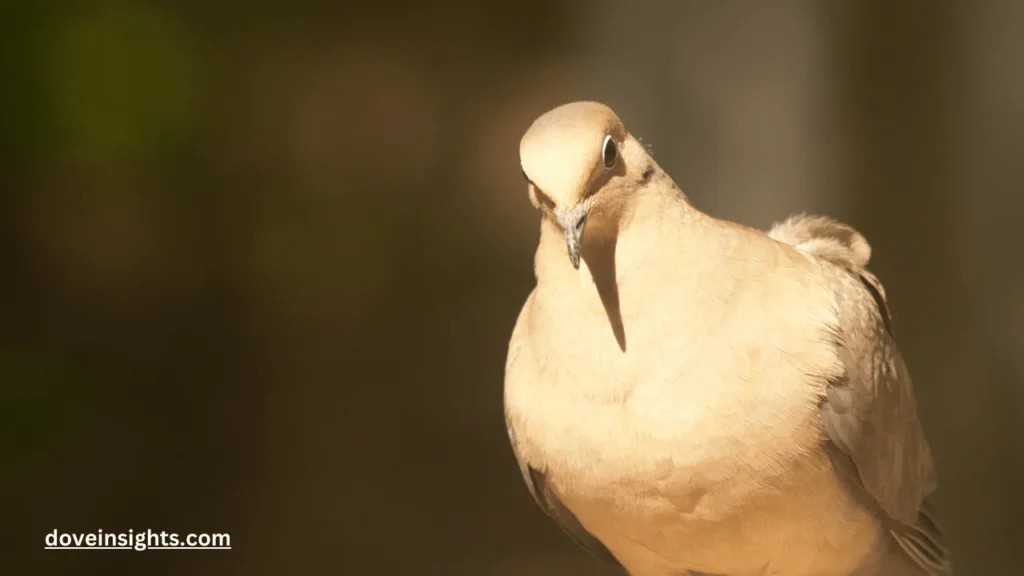Mourning doves are often seen as symbols of peace, their soft coos carrying an air of tranquility over suburban backyards and rural fields.
But do these gentle birds ever display aggressive behavior? The idea of aggression in mourning doves may seem surprising at first—after all, they are known for their calm demeanor and graceful flight. However, like many species, doves can exhibit defensive behaviors, especially during specific times of the year or when they feel threatened.
Understanding mourning dove aggression is crucial for bird enthusiasts, gardeners, and anyone interested in the natural world. While these birds are typically peaceful, their behavior can shift based on environmental stressors, nesting periods, or territorial disputes.
In this article, we will explore the triggers that can lead to aggression in mourning doves, whether they pose a threat to other animals or humans, and what their behavior tells us about their survival instincts.
By the end of this post, you’ll gain a deeper appreciation for these fascinating birds and a clearer understanding of their behavior. Are mourning doves truly as peaceful as they seem, or is there more to their personality than meets the eye? Let’s dive into the nuances of mourning dove aggression to find out.
Contents
- 1 Mourning Doves and Aggression: A Natural Behavior
- 2 Mourning Dove Aggression During the Breeding Season
- 3 Mourning Dove Aggression in Urban and Suburban Environments
- 4 Aggression vs. Defense: Understanding Dove Behavior
- 5 How to Handle Aggression in Mourning Doves
- 6 Understanding Mourning Dove Aggression
- 7 FAQ’s
- 7.0.1 Are mourning doves aggressive toward humans?
- 7.0.2 What triggers aggressive behavior in mourning doves?
- 7.0.3 How do mourning doves communicate their aggression?
- 7.0.4 Do mourning doves fight with other birds?
- 7.0.5 Are mourning doves territorial?
- 7.0.6 Can mourning doves live in urban areas without becoming aggressive?
Mourning Doves and Aggression: A Natural Behavior
Territorial Defense: Mourning doves are known to defend their territories aggressively during the breeding season.
Male doves, in particular, can become highly protective of their nesting areas. This often leads to vocalizations, chasing, and even physical displays meant to assert dominance over other males.
Feeding and Nesting Competition: In areas where food and nesting sites are scarce, doves may become more territorial and confrontational. They use their aggressive displays to ward off other doves and secure their resources.
These behaviors are not just limited to males; even females can show signs of aggression if they feel their nests or offspring are at risk.
Limited Aggression Toward Humans: While doves may become defensive, especially around their nests, they do not generally display aggressive behavior toward humans unless they are directly threatened.
Mourning Dove Aggression During the Breeding Season
Courtship and Mating Rituals: During courtship, male mourning doves can show some aggressive behaviors to attract a mate. Males engage in display rituals, such as puffing out their chests and making cooing sounds to demonstrate strength and suitability as a mate. These behaviors can sometimes escalate into fighting with other males competing for the attention of a female.
Defending the Nest: Once a mate is secured, male doves become highly protective of their nests. If another male tries to encroach on their territory, the defending male may engage in physical aggression, including chasing and pecking. This type of aggression is vital for the survival of their offspring since it ensures that their nest remains undisturbed.
Protective Parenting: Female doves, although generally less confrontational, can also exhibit aggression when protecting their eggs or chicks. They might use subtle warning signals or threaten to defend their young against any potential threats.
Mourning Dove Aggression in Urban and Suburban Environments
Adaptability and Crowding: In urban and suburban areas, mourning doves have adapted well to human presence. However, crowded environments can increase stress and lead to more frequent territorial disputes among doves. In these settings, doves may become more aggressive toward other birds or even humans, especially if food sources are limited or the doves are competing for nesting sites in trees or other structures.
Human Influence on Aggression: Interestingly, human actions like placing bird feeders or providing nesting materials can inadvertently encourage aggression by attracting more doves to the area. These artificial resources create conditions for more competition and, consequently, more territorial conflicts.
Noise and Disruption: Mourning doves in urban areas may also respond to the noise and chaos of the city with heightened alertness, making them more prone to defensive behaviors. While not overtly aggressive, they can be more nervous and skittish, displaying defensive postures or flight responses when disturbed.
Aggression vs. Defense: Understanding Dove Behavior
Defensive vs. Aggressive Actions: It’s important to differentiate between aggression and defensive behavior. While mourning doves are not typically aggressive toward other species, they are highly protective of their young, territory, and mates. The act of chasing away intruders, or even engaging in a brief scrap, is often a defense mechanism rather than an expression of true aggression.
Why Aggression Is Essential: Aggression, or at least assertiveness, plays a key role in survival. Mourning doves’ ability to protect their nests from predators or rival males ensures that they can raise healthy offspring. It also allows them to establish dominance over areas with access to food and shelter, critical resources for their survival.
Communication Through Aggression: Mourning doves communicate not only through coos but also with body language and display postures. They might puff up their feathers, raise their tails, or engage in other actions to signal dominance or deter threats. While these behaviors can seem aggressive, they are more about communication than actual conflict.
How to Handle Aggression in Mourning Doves
Respect Their Space: If you encounter mourning doves in your yard or garden, it’s important to respect their space and avoid disturbing them, especially if they are nesting. Allowing them to feel secure in their environment reduces the likelihood of aggression.
Provide Safe Habitats: You can minimize potential stressors by creating safe spaces for mourning doves, such as providing calm, secluded spots for nesting and feeding. This helps to maintain peaceful interactions and prevents unnecessary territorial disputes.
When Aggression Becomes a Concern: In some rare cases, if mourning dove aggression seems excessive or threatens human safety, consider contacting local wildlife authorities or bird conservation organizations for advice on how to handle the situation.
Understanding Mourning Dove Aggression

Recap of Key Points: Mourning doves, while often regarded as peaceful creatures, can display aggressive behavior, particularly during the breeding season when defending their nests or territories. These birds engage in aggressive behaviors to protect their young, secure mates, and ensure access to resources. However, their aggression is often more defensive than inherently hostile.
Final Thoughts: While mourning doves are generally gentle, their occasional assertiveness and territorial nature play crucial roles in their survival and reproductive success.
By understanding these behaviors, we can better appreciate their complexities and create environments that allow both humans and mourning doves to coexist peacefully.
So next time you encounter one of these graceful birds, remember that aggression, when it occurs, is simply part of their natural instincts to thrive and protect their future generations.
FAQ’s
Are mourning doves aggressive toward humans?
No, mourning doves are not typically aggressive toward humans. While they may become defensive around their nests, they are generally gentle and will avoid contact with people. Any aggression shown is usually due to the birds feeling threatened or stressed, especially during the breeding season.
What triggers aggressive behavior in mourning doves?
Aggression in mourning doves is most often triggered by the need to protect their territory or young. Males can become aggressive when competing for mates or defending their nesting sites. These behaviors are more defensive than outright aggression and are necessary for their survival.
How do mourning doves communicate their aggression?
Mourning doves use a variety of body language and vocalizations to communicate aggression. They may puff up their feathers, extend their wings, and make loud cooing sounds. Males might also engage in chasing or even physical encounters with other males to establish dominance.
Do mourning doves fight with other birds?
Yes, mourning doves may engage in territorial fights with other doves or birds. However, they are not as aggressive as some other species like crows or starlings. Their confrontations are typically brief and are focused on securing a mate or a suitable nesting site.
Are mourning doves territorial?
Yes, mourning doves are territorial, especially during the breeding season. Males establish and defend their territory using vocalizations and physical displays to ward off other males. These territories ensure access to resources like food and nesting sites for their offspring.
Can mourning doves live in urban areas without becoming aggressive?
Mourning doves can adapt well to urban environments and often thrive in cities and suburbs. However, in crowded urban settings where resources are limited, they may become more territorial or stressed, which can lead to increased aggression toward other doves or birds. Creating safe and abundant environments can help reduce these behaviors.








